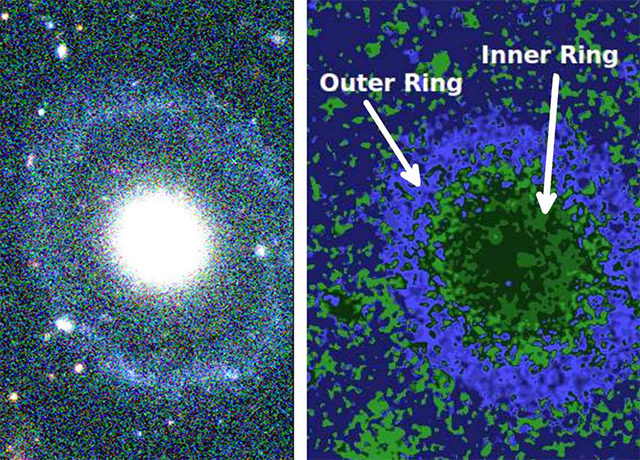Astronomers Have Photographed A Rare Double Ring Galaxy
Fuck! Looks like today’s posts are all about space. How is this, how is this for your astronomical-prostate? Astronomers have spotted a double ring galaxy. Yeah, it’s rad, right? Yeah, it’s rubbing right up against the space-gland, innit?
See those photos above? That’s our first look at PGC 1000714, a galaxy 359 million light-years away from our planet that’s unlike most of the galaxies we’ve observed before. While most galaxies we know are spirals like our own, PGC 1000714 is more similar to Hoag’s Object that was discovered back in 1950. They’re both ring galaxies characterized by a nucleus surrounded by a star-forming outer ring, except this one has two outer bands instead of one.Astronomers from the University of Minnesota Duluth and the North Carolina Museum of Natural Sciences found the second ring when they used a large diameter telescope in Chile to observe the unique structure. They collected multi-waveband images of PGC 1000714 to determine the ages of its nucleus and bluish outer band — in the end, they found both the answers to their questions and a fainter, reddish inner ring.
Since the rings are regions where stars form from colliding gas, their different colors suggest that the galaxy experienced two different formation periods. The red inner ring is older and probably much closer in age to the 5.5-billion-year-old red nucleus, while the blue outer band has only been around for 0.13 billion years.
The astronomers don’t think they can figure out how the rings formed based on the data they have. They believe, however, that the outer band could be a result of incorporating a gas-rich dwarf galaxy that used to be nearby. According to project lead Burcin Mutlu-Pakdil, “less than 0.1% of all observed galaxies are Hoag-type galaxies.” By observing all the rare ones we find, we learn more about how galaxies form and evolve.




